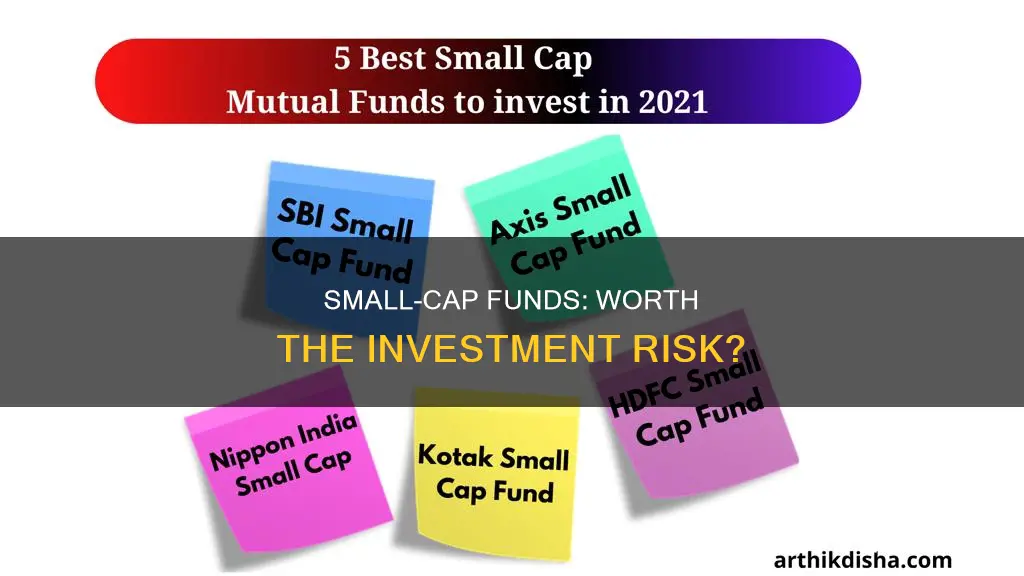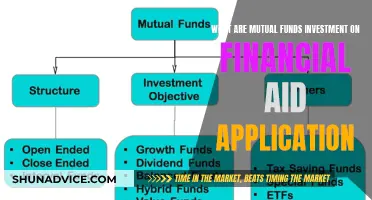
Small-cap funds are a type of investment fund that focuses on companies with a small market capitalization, typically ranging from $250 million to $2 billion. While small-cap funds have historically offered higher growth potential compared to large-cap stocks, they also come with increased risk and volatility. The success of small-cap funds relies heavily on the ability of fund managers to identify promising investments, and they are best suited for investors who can tolerate short-term losses and sharp fluctuations in value. Small-cap funds tend to perform well over longer periods, and their volatility can lead to significant returns during bull markets. However, they are more vulnerable to economic downturns and market crashes. Before investing in small-cap funds, it is crucial to understand the associated risks and conduct thorough research.
| Characteristics | Values |
|---|---|
| Market Capitalization | $250 million to $2 billion |
| section | Higher growth potential |
| Volatility | Higher |
| Risk | Higher |
| Returns | Higher |
| Investor Profile | section Suited for investors who can accept more risk for higher potential gains |
| Time Horizon | Long-term |
| Investment Strategy | Active investment strategy required |
| Performance | Outperformed large-cap stocks historically but underperformed in recent years |
What You'll Learn

The pros of small-cap funds
Small-cap funds are a type of investment fund that focuses on companies with a small market capitalization, typically ranging from $250 million to $2 billion. While these funds come with certain risks, they also offer several potential benefits for investors.
Higher Growth Potential
Small-cap companies have a greater potential for growth compared to large-cap companies. Their smaller size means they have more room to expand, innovate, and increase their revenue. This translates into higher growth potential for investors, who can capitalize on the opportunity to get in on the ground floor of up-and-coming businesses.
Historical Outperformance
Historically, small-cap stocks have outperformed large-cap stocks over the long term. This phenomenon is often referred to as the "small-cap effect" and is based on academic research spanning several decades. The rationale behind this effect is that small-cap companies compensate investors for the additional risk they bear by offering higher returns.
Beat Institutional Investors
Small-cap stocks provide an opportunity to beat institutional investors. Many mutual funds have internal rules restricting them from investing heavily in small-cap companies. Additionally, regulations prohibit mutual funds from owning more than 10% of a company's voting stock, making it challenging for them to build a significant position in small-cap stocks. This gives individual investors an advantage in identifying promising small-cap companies before institutional investors enter the market.
Variety of Businesses
Small-cap companies are not limited to start-ups. They can be found across various industries and include well-established businesses with strong track records and solid financials. This diversity provides investors with a range of options beyond simply investing in young companies.
Less Popular Information
Small-cap companies do not receive the same level of coverage and attention from financial institutions and analysts as large- and mid-cap companies. As a result, they tend to be less popular and are often priced below their intrinsic value. This lack of popularity can provide savvy investors with solid returns, as they can identify and invest in undervalued companies.
Strategies to Cease Mutual Fund Investments: A Guide
You may want to see also

The cons of small-cap funds
Small-cap funds are considered riskier than large-cap funds. They are more volatile and susceptible to market changes. This means that while they can offer higher growth potential, they also carry a higher risk of loss. Here are some detailed reasons why investing in small-cap funds may not be suitable for everyone:
High Risk and Volatility
Small-cap companies have a greater potential for growth, but they also have an equal chance of failing. They are more vulnerable to recessions, market crashes, and economic downturns. Their smaller size and limited financial cushion make them more sensitive to market volatility, resulting in sudden and wide price fluctuations. This volatility can lead to short-term losses and sharp ups and downs in investment value, which may not be suitable for risk-averse investors.
Less Financial Stability
Small-cap companies tend to have smaller customer bases and are often tied to specific geographical areas. This makes their prospects more uncertain, and they may struggle to survive during challenging economic periods. Their limited access to investment capital and higher bankruptcy likelihood make them a riskier investment choice.
Time-Consuming Research
Investing in small-cap funds requires extensive research due to the lack of available information. Financial institutions and analysts provide less coverage of small-cap companies compared to large- and mid-cap ones. Investors need to devote significant time and effort to understanding company valuations and conducting their own research before investing.
Low Liquidity
The smaller size and lower popularity of small-cap companies can result in low liquidity. It may be more difficult to find sellers when purchasing shares and to find buyers when exiting the market. This lack of liquidity can make it challenging to enter or exit investments at desired prices.
A Guide to Investing in Calvert Funds Wisely
You may want to see also

How to invest in small-cap funds
Small-cap funds are a risky but rewarding investment option. They are best suited for investors who are willing to accept more risk in exchange for higher potential gains. Here are some things to keep in mind when investing in small-cap funds:
Research and Analyse:
Before investing, it is crucial to conduct thorough research and analysis. Study the financial health and growth potential of the companies in the small-cap fund. Evaluate their earnings and revenue growth, price-to-earnings ratio, and price-to-sales ratio. This due diligence will help you make informed investment decisions.
Diversification:
Diversifying your investment across different small-cap companies can help mitigate the risk associated with small-cap funds. Most small-cap funds invest around 60-90% in small caps and the rest in mid-caps and large caps to provide some stability to the investment.
Long-Term Investment:
Small-cap funds are typically volatile and prone to short-term fluctuations. Therefore, it is advisable to invest in small-cap funds for the long term, usually a minimum of 5-6 years. This allows your investment to weather short-term market swings and increases the potential for higher returns over time.
Systematic Investment Plans (SIPs):
Consider investing in small-cap funds through a Systematic Investment Plan (SIP). SIP allows you to invest a fixed amount regularly, spreading your risk over a more extended period. This approach is suitable for those who want to invest a smaller amount each month instead of a lump sum.
Mutual Funds and Exchange-Traded Funds (ETFs):
If researching individual small-cap stocks seems too time-consuming or risky, consider investing in small-cap mutual funds or exchange-traded funds (ETFs). These funds provide exposure to a diversified portfolio of small-cap companies, reducing the overall risk.
Timing the Market:
Keep an eye on economic indicators and market trends. Small-cap stocks are considered economically sensitive, tending to rally in recoveries and lag when heading into recessions. Therefore, it may be strategic to invest in small-cap funds when the economy is rebounding, unemployment rates are decreasing, and businesses are experiencing strong earnings growth.
Remember, investing in small-cap funds carries higher risk than investing in large-cap funds. Ensure you thoroughly understand the risks and rewards before making any investment decisions.
Virtual Fund Investment: Strategies for Beginners
You may want to see also

Are small-cap funds a good investment?
Small-cap funds can be a good investment, but they are not suitable for all investors.
Small-cap funds invest a large portion of their portfolio in companies with a small market capitalization, typically between $250 million to $2 billion. These funds are best suited to investors who are willing to accept more risk in exchange for higher potential gains.
Small-cap funds have the potential to deliver outsize returns compared to larger companies. They have historically outperformed large-cap stocks and are often the large-cap stocks of the future. For example, Amazon and Netflix were once small-cap stocks, and an initial investment in these companies would have appreciated by more than 100 times.
However, small-cap funds are more volatile and riskier than large-cap stocks. They are followed by fewer investors and analysts, and their prices can fluctuate more in response to news and market changes. They are also more vulnerable to recessions and market crashes.
Small-cap funds are best suited for long-term investors, as they tend to perform well over a long period of time. For example, small-cap value index funds have outperformed the S&P 500 in the long run.
In summary, small-cap funds can be a good investment for those willing to accept higher risk and volatility in exchange for the potential for higher returns. However, they are not suitable for short-term investors or those who are risk-averse.
Rebalancing Your American Funds Portfolio: A Step-by-Step Guide
You may want to see also

Small-cap vs large-cap funds
Small-cap funds invest in companies with a market capitalization between $250 million and $2 billion. Large-cap funds, on the other hand, invest in companies with a market capitalization of $10 billion or more.
Small-cap funds are considered riskier than large-cap funds as they invest in younger companies with less established track records. Small-cap funds offer higher growth potential but also come with greater volatility and risk. Large-cap funds, meanwhile, offer more stability and are typically blue-chip companies with a long history of dependable earnings.
Small-cap funds are best suited for investors with a high-risk tolerance and a long-term investment horizon. These funds can provide aggressive returns but also carry the possibility of short-term losses. Large-cap funds, on the other hand, are more conservative and are suitable for investors seeking long-term returns with less risk.
In terms of liquidity, small-cap funds have less liquidity compared to large-cap funds. This means that it may be harder for investors to buy or sell small-cap fund holdings. Small-cap funds are also more volatile and their prices can fluctuate significantly in a single trading day. Large-cap funds, due to their larger size and more stable nature, tend to be less volatile and provide better liquidity.
When it comes to returns, small-cap funds have historically outperformed large-cap funds over the long term. However, small-cap funds tend to be more volatile and risky in the short term. Large-cap funds offer steady and consistent returns but with less volatility.
In summary, small-cap funds offer higher growth potential but come with greater risk and volatility. Large-cap funds provide more stability, less risk, and consistent returns. The choice between investing in small-cap or large-cap funds depends on an investor's risk tolerance, investment horizon, and return expectations.
Best Countries to Invest in Mutual Funds
You may want to see also
Frequently asked questions
Small-cap funds are investments in companies with a small capitalization, typically between $250 million and $2 billion.
Small-cap funds offer higher growth potential than large-cap stocks. They also tend to have higher growth rates and are followed by fewer investors and analysts, which can lead to greater returns.
Small-cap funds are very risky and volatile, and they may not be suitable for short-term investors or those who are risk-averse. They are also more susceptible to market changes and economic downturns.
Small-cap funds are best suited for investors who are willing to accept more risk in exchange for higher potential gains and have a good understanding of mutual funds and their risks.







